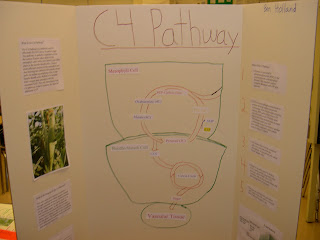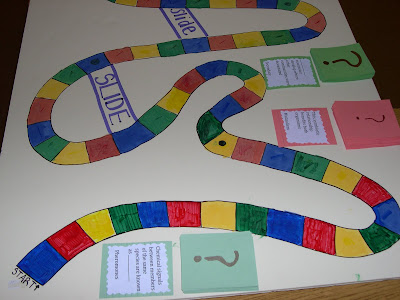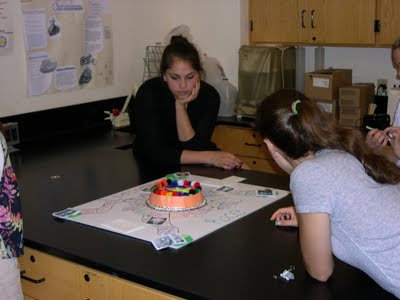C. Barth and R. James made custom cupcakes to celebrate their classmates acceptance into college. Each cupcake had the initial of the college.
Science News and Happenings of Interest to the Bronxville School Community
Friday, December 16, 2011
Friday, December 2, 2011
AP Biology Students' Bioenergetics Projects
Student prepared posters and PowerPoint presentations examining the metabolic pathways of respiration and photosynthesis.
A. Austi
Austi Anaerobic vs Aerobic Respiration
C. Barth
Barth_photophosphorylation
Dennen CAM Pathways
W. Dougherty
Dougherty Second Quarter Project
M. Ebrahim
Ebrahim metabolicpathways
T. Ennis
Ennis Evolution of Metabolic Pathways
J. Faselt
jackie_faselt_ppnt
T. Hudson
Hudson CAM Plants Project_2
R. James
James AP Bio Respiration vs Photosynthesis
J. Keating
Keating Mitochondria
A. Lemberger
Lemberger Anaerobic vs 1
O'Toole glycolysis
Pass Photosynthesis vs Respiration
Walsh C4 PLants Apbioc4cycle
A. Weiden
Weiden Krebs Cycle
 |
| B. Holland |
 |
| Ja. Harrison |
 |
| Jo. Harrison |
 |
| D. Mooney |
 |
| G. Connors |
 |
| M. Rizzo |
 |
| H. Goldberg |
 |
| D. Jackson |
 |
| T. Grantham |
 |
| B. Forst |
A. Austi
Austi Anaerobic vs Aerobic Respiration
C. Barth
Barth_photophosphorylation
Dennen CAM Pathways
W. Dougherty
Dougherty Second Quarter Project
M. Ebrahim
Ebrahim metabolicpathways
T. Ennis
Ennis Evolution of Metabolic Pathways
J. Faselt
jackie_faselt_ppnt
T. Hudson
Hudson CAM Plants Project_2
R. James
James AP Bio Respiration vs Photosynthesis
J. Keating
Keating Mitochondria
A. Lemberger
Lemberger Anaerobic vs 1
O'Toole glycolysis
Pass Photosynthesis vs Respiration
Walsh C4 PLants Apbioc4cycle
A. Weiden
Weiden Krebs Cycle
Saturday, November 19, 2011
Core Biology Cell Organelle Presentations and 3D Models
 |
| Mitochondrion Model by P. Bisconti, D. Borcich, A. Falcon |
Mitochondria Project by P. Bisconti, D. Borcich, A. Falcon
 |
| Plasmids and Vacuoles by K. Monaco, G. Yienger |
 |
| Plasmids and Vacuoles by K. Monaco, G. Yienger |
Vacuoles and Plasmids by K. Monaco, G. Yienger
 |
| Cell Membrane and Cell Wall Model by J. Bothwell and E. Kister |
Biology Cell Wall and Membrane by J. Bothwell and E. Kister
 |
| Endoplasmic Reticulum by T. Diaz, O. Hayes, M. Lewis |
Endoplasmic Reticulum and Ribsomes by T. Diaz, O. Hayes, M. Lewis
 |
| Nucleus by T. Bremar, P. Meade, S. Walsh |
Nucleus Project by T. Bremar, P. Meade, S. Walsh
 |
| Cytoplasm by C. Cory, L. Sapon |
Cytoplasm Cytoskeleton by C. Cory, L. Sapon
Saturday, October 29, 2011
Wednesday, October 26, 2011
AP Biology Water Projects
A. Austi's Project
A Austi the Properties of Water
C. Barth's Project
Barth Properties of Water
G. Connors' Project
Connors Water Properties Term Paper - AP Bio
W. Dougherty's Project
W Dougherty Water Project
E. Ebrahim's Project
Ebrahim Water Properties
T. Ennis's Project
Explore the Wonders of Water Blog/Web Site
J. Faselt's Project
J Faselt Water
H. Hudson's Project
Hudson Water
R. James' Project
James AP Bio Water Project PPT
J. Keating's Project
Keating Water Properties
A. Lemberger's Project
Lemberger Water Properties
G. Lilly's Project
A. Moran's Project
Moran Water Phenomena
I. Palfrey's Project
Ian Palfrey Term Paper Water Properties
A. Pass' Project
A Pass Water
B. Walsh's Project
Walsh apbiowater
A.Weiden's Project
Weiden Water Phenomena
Monday, June 13, 2011
Grade 6 Geology Exposition
Mr. Viggiani's Sixth Grade class prepared models and exhibits to illustrate geological forms.
 |
| A representation of Yellowstone Park's "Beehive Geyser", so named because its cone's shape reminds one of a beehive. To learn more about it follow this link - http://www.geocities.com/Yosemite/1407/ugb_major.htm#beehive |
 |
| Beware dangerous cavern up ahead!! |
 |
| Experienced spelunkers needed for exploration. Proceed at your own risk! |
 |
| Sixth graders emerging and posing for a group shot as they exit the cavern model. |
 |
| Check out this cool representation of a hot spring!!! Thermophiles are just aching to cool their heels in this luxury spring. Here is a link by a hot springs enthusiast - http://www.hotspringsenthusiast.com/ - from this site you can find the locations of hot springs in the US. To learn more about thermophiles follow this link - http://spider.ipac.caltech.edu/staff/jarrett/LiU/class/Project/thermophiles.html |
Friday, June 10, 2011
After the AP Exam: Juniors Board Game Project
After the AP Exam, the juniors in the class spent a the first two weeks reviewing for the NY Regents Living Environment exam. Over the last week and a half they have been working on the Game Board project.
Fourth Quarter First Project Newsletter 2011
Erin and Caitlin developed "BIOLAND" for their board game as a way to review ecology. Their game board layout is reminiscent of the childhood classic Candyland.
David, Robbie, and Joey developed the "EVOLUTION CHALLENGE" in which each player represents a species and their goal is to survive.
Bryana, Catherine and Katerine developed the "Ribosome Race" whose play is similar to the game "Sorry!"
Margaret, Paige and Shea based their game on "Twister". Their modification requires a biological question to be answered before the indicated move can be taken.
Fourth Quarter First Project Newsletter 2011
Erin and Caitlin developed "BIOLAND" for their board game as a way to review ecology. Their game board layout is reminiscent of the childhood classic Candyland.
Instructions
- Select your playing piece and place him or her on the starting space.
- Choose the order of play. Some people like to decide using "Rock, Paper, Scissors," while other roll a die.
- Each player rolls the die when it is their turn and proceed the number of spaces indicated by their role.
- Whatever color the player lands on, they take a card of the top of that color's pile.
- The card will have a question pertaining to ecology. Answering correctly is rewarded with advancing a space forward. Answering incorrectly is penalized by moving a space back.
- If a player lands on a space containing a dot, they forfeit a turn.
- Play ends when one player makes it to the finish line at the end of the board.
David, Robbie, and Joey developed the "EVOLUTION CHALLENGE" in which each player represents a species and their goal is to survive.
Instructions
- The point of the game is to move your species across the board as it's evolutionary changes bring both benefits and harm.
- Player rolls the dice.
- On an even roll, draw an even evolution card; on an odd roll draw an odd evolution card. Follow the directions on your card and return it to the bottom of the pile.
- If you land on a "Bonus Space" you must draw a bonus question card. If you answer the question correctly, your species will advance according to the card. If you answer incorrectly, your species will be set back the number of spaces according to the card.
Bryana, Catherine and Katerine developed the "Ribosome Race" whose play is similar to the game "Sorry!"
Instructions
- The object of "Ribosome Race" is to move all the game pieces around the cell nucleus and return to their original ribosome.
- A player is complete when all of their scientists (game pieces) have returned to their original ribosome.
- All pieces must move around the nucleus in a counter clockwise direction, following the game board arrows.
- Play begins when players roll the die to determine the order of their play (highest roll goes first.
- On the roll of the die, the player progresses the number of spaces indicated on the die and follows the directions on the space where they land.
- If they land on a question space they must answer the question correctly to remain in their position, an incorrect answer returns them to their position before the roll of the die.
- The first player to return all their pieces to their ribosome is the winner.
Margaret, Paige and Shea based their game on "Twister". Their modification requires a biological question to be answered before the indicated move can be taken.
Subscribe to:
Comments (Atom)





























